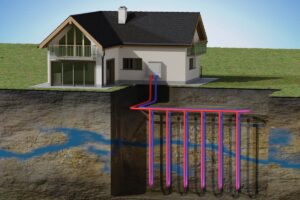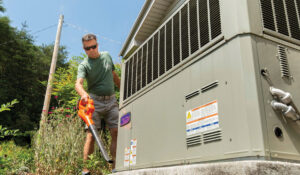
By now your furnace has been running three or four hours a day and your home is starting to feel a little dry, just like last year and the year before that. So, you make your annual pilgrimage to the basement to bring up and fill your freestanding humidifier, or turn on your furnace mounted humidifier so your sinuses won’t dry out at night. When you were kid your mom kept a pan of water on the stove or a register to keep the humidity up in the home. It’s just what we do in the winter. Right?
But why do we need to keep adding moisture to our homes in the winter? Growing up we were told the home was dry because the “scorched air furnace” cooked the moisture out of the air.
Well, not exactly. The one thing that was correct was that when air is heated, humidity goes down, but this is not the whole story.
Relative humidity (RH) is the amount of moisture (in percent) in the air compared to what the air can “hold” at that temperature. Warmer air can hold more moisture than cooler air. Rule of thumb: Relative humidity doubles with each 20 degree decrease, or is reduced by half with each 20 degree increase in temperature.
Let’s recap: heat air up, RH goes down, cool air down, RH goes up. Or, to make it real simple: “cold = wet,” “warm = dry”.
This is why hair and clothes dryers use heat to dry. If you want to dry something, heat it up!
So here is the rest of the story, the important point. The real reason the humidity in your home may be low is because the air leakage of your home is too high.
You don’t need a humidifier. You need to air seal your home!
Adding humidity to your home in the winter is addressing the symptom and not the root cause of the problem. Homes are constantly losing and gaining moisture all hours of the day and night. As long as the home loses about the same as it gains, and we can maintain 35 to 40 percent RH, our homes are happy and so are sinuses, etc.
Let’s look at three different homes from a winter time humidity point of view. Which of the three homes is most like yours?
Dry home: This home cannot maintain a reasonable humidity level because the home has too much air infiltration-too much drying potential. When the air infiltration rate of a home is 5 to 7 air changes per hour (ACH) and higher, as measured with the blower door test, the home is diluted with too much outside air keeping the humidity levels low. Conventional wisdom tells us to add humidity when the real solution is to lower the air infiltration of the home to keep more moisture in the home.
No humidity problems, high or low: This home has about the same drying potential through air infiltration and mechanical ventilation (kitchen and bath fans) as moisture being generated in the home. Great!
Wet home: This home has tight construction and there is little drying potential from air leakage. The home may have signs of excess moisture such as excessive condensation on the windows and small patches of mold growth around the home. The tighter the home the more important mechanical ventilation is to regulate and maintain our 35 to 40 percent RH.
Building professionals and homeowners tell me all the time, “If you get a home too tight, you will have mold. The home needs to breathe.”

In all my years of diagnosing homes with excess moisture issues, 100 percent of them had either excessive moisture sources, poor mechanical ventilation, or some of both. The tightness of the home was NOT the problem.
I recommend that homeowners monitor their humidity levels with a digital temperature and humidity gauge like the one pictured here. Place the humidity gauge at tabletop height. Do not hang the gauge on a wall. Airflow from ceiling fans or registers can affect the readings. If your humidity is low, contact your local electric cooperative about scheduling a blower door test. If your humidity is high, take a good look around your home for sources of excess moisture and have the airflow of your bath exhaust fans measured to make sure they are moving air and not just making noise.
Remember, in typical homes you should never need to humidify your home.









